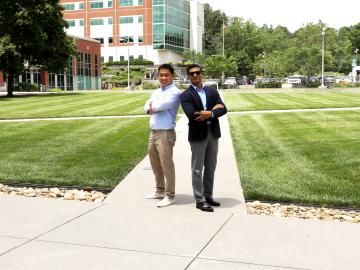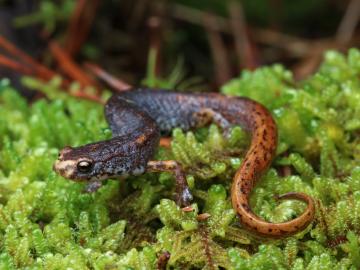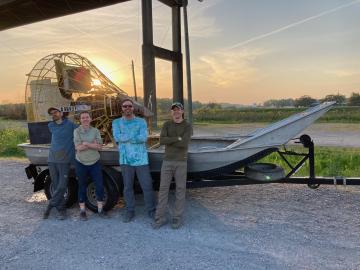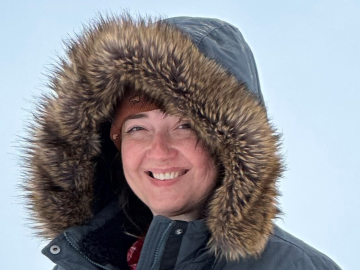
Filter News
Area of Research
- (-) Biology and Environment (122)
- (-) Energy Science (163)
- (-) National Security (24)
- Advanced Manufacturing (9)
- Biology and Soft Matter (1)
- Building Technologies (4)
- Computational Biology (1)
- Computational Engineering (3)
- Computer Science (9)
- Electricity and Smart Grid (1)
- Energy Sciences (1)
- Functional Materials for Energy (1)
- Fusion and Fission (10)
- Fusion Energy (8)
- Isotopes (1)
- Materials (44)
- Materials for Computing (6)
- Mathematics (1)
- Neutron Science (19)
- Nuclear Science and Technology (12)
- Nuclear Systems Modeling, Simulation and Validation (1)
- Quantum information Science (1)
- Supercomputing (84)
News Topics
- (-) Advanced Reactors (7)
- (-) Big Data (21)
- (-) Buildings (38)
- (-) Composites (19)
- (-) Environment (140)
- (-) Machine Learning (25)
- (-) Mercury (10)
- (-) Summit (15)
- 3-D Printing/Advanced Manufacturing (83)
- Artificial Intelligence (26)
- Bioenergy (67)
- Biology (81)
- Biomedical (21)
- Biotechnology (17)
- Chemical Sciences (19)
- Clean Water (19)
- Computer Science (56)
- Coronavirus (24)
- Critical Materials (9)
- Cybersecurity (25)
- Energy Storage (72)
- Exascale Computing (6)
- Fossil Energy (2)
- Frontier (5)
- Fusion (3)
- Grid (44)
- High-Performance Computing (27)
- Hydropower (10)
- Isotopes (2)
- Materials (40)
- Materials Science (32)
- Mathematics (6)
- Microelectronics (1)
- Microscopy (15)
- Molten Salt (1)
- Nanotechnology (12)
- National Security (38)
- Neutron Science (18)
- Nuclear Energy (11)
- Partnerships (17)
- Physics (3)
- Polymers (12)
- Quantum Science (3)
- Security (15)
- Simulation (18)
- Space Exploration (3)
- Statistics (1)
- Transportation (69)
Media Contacts

When geoinformatics engineering researchers at the Department of Energy’s Oak Ridge National Laboratory wanted to better understand changes in land areas and points of interest around the world, they turned to the locals — their data, at least.

Oak Ridge National Laboratory researchers developed a model framework that identifies ways to ensure wildlife can safely navigate their habitats while not unduly affecting infrastructure.

Growing up exploring the parklands of India where Rudyard Kipling drew inspiration for The Jungle Book left Saubhagya Rathore with a deep respect and curiosity about the natural world. He later turned that interest into a career in environmental science and engineering, and today he is working at ORNL to improve our understanding of watersheds for better climate prediction and resilience.

Oak Ridge National Laboratory researchers recently demonstrated use of a laser-based analytical method to accelerate understanding of critical plant and soil properties that affect bioenergy plant growth and soil carbon storage.

Scientist-inventors from ORNL will present seven new technologies during the Technology Innovation Showcase on Friday, July 14, from 8 a.m.–4 p.m. at the Joint Institute for Computational Sciences on ORNL’s campus.

Like most scientists, Chengping Chai is not content with the surface of things: He wants to probe beyond to learn what’s really going on. But in his case, he is literally building a map of the world beneath, using seismic and acoustic data that reveal when and where the earth moves.

When reading the novel Jurassic Park as a teenager, Jerry Parks found the passages about gene sequencing and supercomputers fascinating, but never imagined he might someday pursue such futuristic-sounding science.

Shih-Chieh Kao, manager of the Water Power program at ORNL, has been named a fellow of the American Society of Civil Engineer’s Environmental & Water Resources Institute, or EWRI.

As a biogeochemist at ORNL, Matthew Berens studies how carbon, nutrients and minerals move through water and soil. In this firsthand account, Berens describes recent fieldwork in Louisiana with colleagues.

Colleen Iversen, ecosystem ecologist, group leader and distinguished staff scientist, has been named director of the Next-Generation Ecosystem Experiments Arctic, or NGEE Arctic, a multi-institutional project studying permafrost thaw and other climate-related processes in Alaska.


